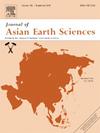长白山火山区微生物特征与CO2扩散排放
IF 2.7
3区 地球科学
Q2 GEOSCIENCES, MULTIDISCIPLINARY
引用次数: 0
摘要
火山活动是驱动碳在内部和地表储层之间转移的主要地质过程之一,在气候变化和全球变暖中起着至关重要的作用。弄清微生物特征与休眠火山地质脱气之间的关系是最重要和最基本的任务之一。本文对东北天池火山冷泉、温泉和土壤的微生物特征(包括细菌、古生菌和真菌)进行了综合研究。研究结果表明,水环境(热泉和冷泉)的微生物多样性与土壤的微生物多样性具有明显的差异,推断干湿脱气系统中微生物驱动的碳循环是不同的。土壤通过微渗漏的CO2扩散排放通量从火山口向周边呈下降趋势,这与微生物群落的多样性和丰富度基本一致。土壤CO2通量与细菌、古细菌和真菌的微生物多样性之间存在中度但显著的相关关系,这与极端火山环境和非火山环境中观察到的结果不同。本研究首次报道了非极端火山环境中微生物群落多样性与土壤CO2通量之间的相关性。这些发现揭示了参与碳循环的微生物的多样性,为进一步深入探索碳循环内在的微生物机制提供了基础。本文章由计算机程序翻译,如有差异,请以英文原文为准。

Microbial characteristics and CO2 diffuse emission in the Mt. Changbai volcanic field, northeast China
Volcanism is one of the principal geologic processes that drive the transferring of carbon between interior and surface reservoirs, playing a crucial role in climate change and global warming. Clarifying the relationship between the characteristics of microorganisms and geological degassing of dormant volcanoes is one of the most important and fundamental tasks. In this study, the microbial characteristics (including bacteria, archaea, and fungi) of cold and hot springs and soil in the Tianchi volcano (TCV), northeastern China were comprehensively studied. Results of this study indicated that the microbial diversities of water environments (hot and cold springs) exhibited distinct characteristics compared to that of the soil, inferring that the microbial-driven carbon cycle in wet and dry degassing systems in the TCV are different. The CO2 diffuse emission flux from the soil through micro-seepage decreased from the crater to the peripheral area, which broadly coincided with the diversity and richness of the microbial community. A moderate but significant correlation was found between soil CO2 flux and microbial diversity of bacteria, archaea and fungi, differing from that observed in extreme volcanic environments and non-volcanic fields. This study is the first to report the correlation between microbial community diversity and soil CO2 flux in a non-extreme volcanic environment. The findings reveal the diversity of microorganisms involved in the carbon cycle, which may provide a foundation for further in-depth exploration of the intrinsic microbial mechanisms in the carbon cycle.
求助全文
通过发布文献求助,成功后即可免费获取论文全文。
去求助
来源期刊

Journal of Asian Earth Sciences
地学-地球科学综合
CiteScore
5.90
自引率
10.00%
发文量
324
审稿时长
71 days
期刊介绍:
Journal of Asian Earth Sciences has an open access mirror journal Journal of Asian Earth Sciences: X, sharing the same aims and scope, editorial team, submission system and rigorous peer review.
The Journal of Asian Earth Sciences is an international interdisciplinary journal devoted to all aspects of research related to the solid Earth Sciences of Asia. The Journal publishes high quality, peer-reviewed scientific papers on the regional geology, tectonics, geochemistry and geophysics of Asia. It will be devoted primarily to research papers but short communications relating to new developments of broad interest, reviews and book reviews will also be included. Papers must have international appeal and should present work of more than local significance.
The scope includes deep processes of the Asian continent and its adjacent oceans; seismology and earthquakes; orogeny, magmatism, metamorphism and volcanism; growth, deformation and destruction of the Asian crust; crust-mantle interaction; evolution of life (early life, biostratigraphy, biogeography and mass-extinction); fluids, fluxes and reservoirs of mineral and energy resources; surface processes (weathering, erosion, transport and deposition of sediments) and resulting geomorphology; and the response of the Earth to global climate change as viewed within the Asian continent and surrounding oceans.
 求助内容:
求助内容: 应助结果提醒方式:
应助结果提醒方式:


